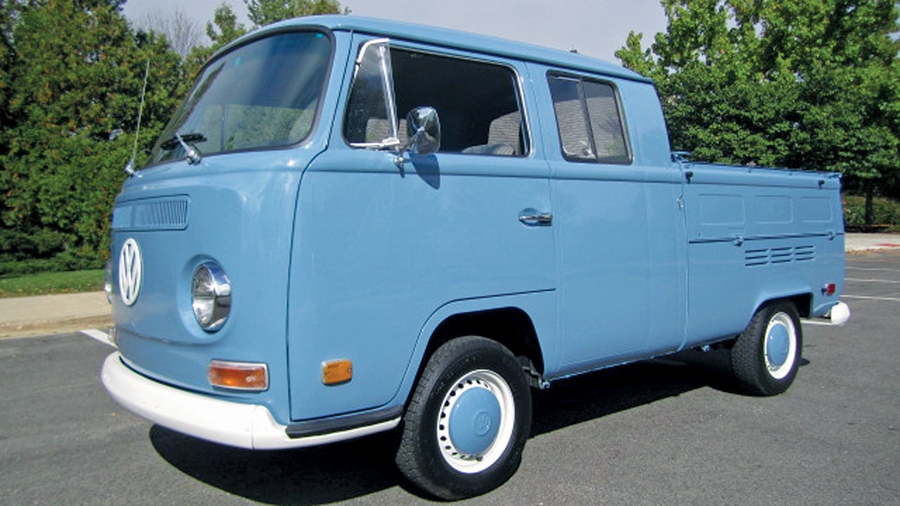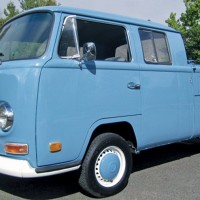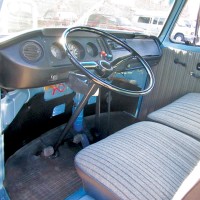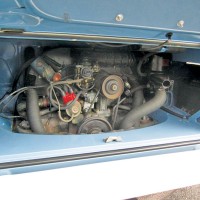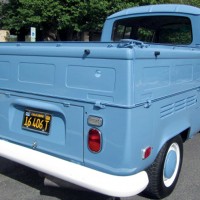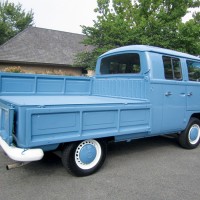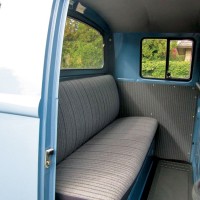• Rare VW Type 2 265 Double Cab Pickup
• 1,600-cc motor
• 4-speed transmission
• Power front disc brakes
• Very few miles since restoration
• New interior
• Two-owner California black-plate car
• Maintenance records
• Extra keys
SCM Analysis
Detailing
| Vehicle: | 1971 Volkswagen Double Cab Pickup |
| Years Produced: | 1968–79 |
| Number Produced: | 277,503 (global production for all 1971 Type 2s); 16,373 (est. double-cab production of 5.9%) |
| Original List Price: | $3,165 |
| SCM Valuation: | $25,000–$35,000 |
| Tune Up Cost: | $150 |
| Distributor Caps: | $10 |
| Chassis Number Location: | Stamped on the engine bay bulkhead, tamper-proof decal on the driver’s door jamb |
| Engine Number Location: | Stamped on crankcase generator support boss |
| Club Info: | Vintage Volkswagen Club |
| Website: | http://www.vvwca.com |
| Alternatives: | 1961–64 Chevrolet Corvair 95 Rampside/Loadside, 1961–67 Ford Falcon Econoline pickup, 1964–67 Dodge A-100 pickup |
| Investment Grade: | C |
This pickup, Lot F199.1, sold for $34,560, including buyer’s premium, at Mecum Auctions’ Chicago sale on October 10, 2014.
Although a pickup truck version of the Volkswagen Type 2 Transporter was first available from the factory in 1952, that was a traditional style with a single bench seat, and enthusiasts now call it a Single Cab.
The Double Cab (a version with two rows of seating that would be called a Crew Cab if it were made by the Big Three in Detroit) was available as a post-VW conversion option.
While the Double Cab was not a runaway success, it did well enough that VW elected to build them in-house starting in 1959 — and the model stayed in production for three decades.
Dropping three sides
Only International Harvester offered a factory-built optional crew cab/double cab pickup earlier — in 1957. Also of note is that these cabs from both International Harvester and VW were three doors (two up front, one on the curb side for the rear passengers). While the Cornbinder became a four-door double cab in 1961, VW stayed with three doors for their entire production run.
Although drop-down cargo box sides were common on European light-duty trucks — even before World War II — the VW’s drop-down sides were new to the American market.
Drop-down sides are more practical for a rear-engine pickup, and the VW version worked better than the 1961–64 Chevrolet Corvair 95 Rampside. The VW could be operated with all three sides folded down as a flatbed (bearing in mind that the rear panel would cover the taillights).
A new personality
The Volkswagen Type 2 Transporters were completely revised for the first time in 1968. The second generation modifications weren’t as drastic as seen in later generations, but they were the most defining in the eyes of Volkswagen fans.
The truck was still boxy, but the styling was more restrained, with flatter body panels. The single-body character line fully encircled the slightly larger body at the base of the roofline. The front panel was less curved, with a large rectangular step over the first generation’s deeply defined Veed front.
There was more glass, and a modern, single-piece curved windshield replaced the flat dual panes. This feature also spawned the popular “Bay Window” nickname for the second-gen transporters.
The new Type 2 also featured an all-new side cargo door. A large, single sliding door replaced the previous dual doors.
Another fundamental change was in nomenclature. The name “Microbus” was no longer used for the passenger van, which was now officially called the “Station Wagon” (fake DiNoc wood paneling was never a factory option).
All other body style configurations — including both single- and double-cab pickups — were carried over into the second generation. Overall, the second wave of VW Transporters was more conservative than the original. And being conservative was not at all what most enthusiasts were into.
Yet the Bay Window series also saw increases in sales, confirming that the 17-year-old Transporter series was due for a change.
The second-generation Transporter sold well enough that it remained in production in Germany until 1979. It finally went out of production in Brazil on December 31, 2013 — as the last rear-engine VW.
The end of an era — in the U.S.
Our subject 1971 Double Cab example is from the only year for the dual-port 1,600-cc engine, and it was the last year of the original smaller taillights.
1971 also brought power front-disc brakes to the VW Transporter lineup.
Yet 1971 was the final year for both single- and double-cab VW pickups in the United States. Tariffs put a big dent in U.S. sales, and many VW dealers kept unsold double- and single-cabs as service and errand trucks.
However, both types of pickups continued in production in Germany. Second-generation production ended in Germany during 1979. Third-generation double- and single-cabs were made in Germany during from 1980 to 1991.
Post-1971 single- and double-cabs now in the U.S. have been imported from Canada or Mexico, or they could be Gray Market imports from Europe. All of these later pickups may have caveats regarding titling depending upon a specific state.
As such, our subject 1971 VW Double Cab represents the last year of no-worries titling in at least 49 states. That in itself is one reason for the strong price paid in Chicago.
Second-gen values rising
Our subject pickup also has a newer, competent restoration back to pure-stock condition. Bone-stock pickups of all flavors and vintages are seeing strong increases in sale prices these days, so it’s no surprise that our example sold well.
While second-generation VW Transporters will never equal the value of the original generation of hippie vans, the 1968–79 models are moving up.
I have recently seen increased prices on excellent examples of second-gen Transporters. This is happening even as first-gen Transporters are riding a downward correction from the stupid-money days of the past couple years.
I won’t go so far as to say that the second-gen Transporters are finally getting their day in the sun. I suspect that it’s because some cars and trucks from the 1970s are now accepted as collectible instead of cheap used cars from a dysfunctional automotive era — the Bay Window Transporter definitely fitting the bill.
In addition, the second-gen VW Transporters have proved true to their original predecessors, and now even the fans of first-generation Type 2 Transporters can accept Bay Windows as real, air-cooled Volkswagens.
It used to be that 1970s VW Beetles got the cold shoulder from the small-window and split-window enthusiasts (I’ve been there, done that, with a 1974 Super Beetle in 1988). Now, all air-cooled Beetle fans are generally amiable. While they’re still not one big, happy family, at least they can all get along with each other. The same applied to the first two generations of Type 2s.
At first glance, our subject Double Cab Pickup looks well sold. However, when you consider all the factors, this sale is market-correct. In fact, this sale has the potential to make the buyer glad it was bought now rather than later. ♦
(Introductory description courtesy of Mecum Auctions.)
